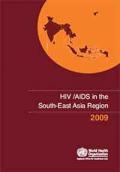Publications - Released in 2009
Since the first case of AIDS was reported from Thailand, a quarter of a century ago, the epidemic in the South-East Asia Region has grown massively. Today, HIV has been reported from 10 of 11 countries in the Region. Nearly 3.5 million people are currently living with HIV/AIDS in the Region, and the epidemic is still evolving.
HIV policies and programmes should be based on evidence and firmly rooted in the science of epidemiology. This annual report on “HIV/AIDS in the South-East Asia Region 2009”, presents the current epidemiological situation as well as recent progress in universal access to HIV prevention, care and treatment, based on data reported by Member countries of the Region.
The report highlights that HIV continues to disproportionately affect marginalized populations. Transmission of HIV is fueled by risky sexual and injecting practices and high rates of sexually transmitted infections.While remarkable progress has been made in assuring safe blood transfusion services, expanding testing and counselling facilities and to some extent in scaling-up antiretroviral treatment programmes, there are many shortfalls that need urgent attention.
Downloads
Organizations
- World Health Organization (WHO)






